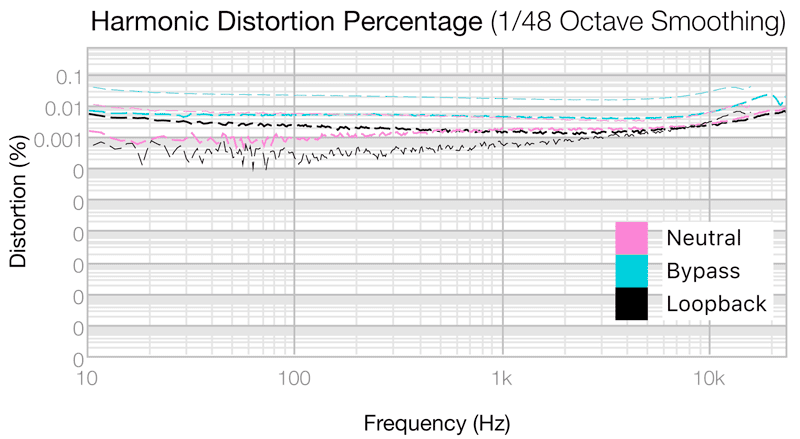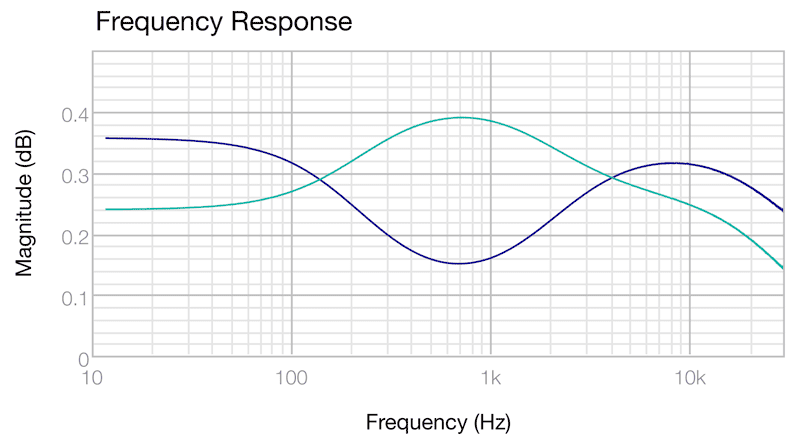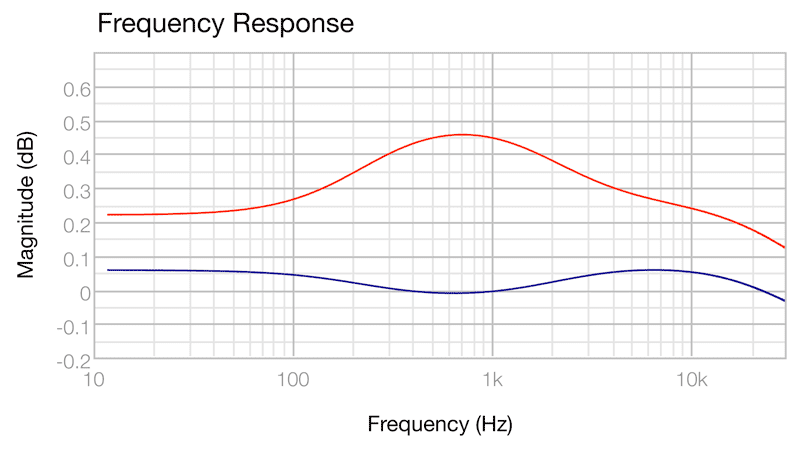Mikhail Naganov
JDS Labs Subjective3 Tone Control
I know, JDS Labs themselves call it “3 Band EQ”, but I think it’s more appropriate to consider it as a good old traditional tone control. There is nothing bad in having tone controls, in fact I’ve already been looking for one—I’ve even fitted BBE’s Sonic Maximizer into its role, although it’s missing attenuation capabilities, so I was very glad to learn that there is a real tone control available.
The first thing I’ve tried using Subjective3 was to tame excessive high frequencies in Beyerdynamic T90 headphones, and add a bit of bass to them, and it worked out great! Here are the knob positions I’ve ended up with for that:
And here is the resulting frequency response—it’s what we can call a “tilt”:
Then I did some exploratory measurements of the device to check how transparent it is. My general worry was that there are phase shifts, or extra group delay, or distortions. But it turns out that the device is pretty nicely engineered.
So let’s see. First I’ve checked the bypass mode, then engaged mode with all the controls set to neutral position. The only graph where I saw any changes was THD:
Here, the bolder plots are the 2nd harmonics level, and the thinner plots are the 3rd harmonics.
Then I’ve started twisting the knobs to their minimum and maximum positions. In fact, JDS Labs have already shown the frequency responses, but no information about phase behavior and harmonics. So I’ve checked what happens if all knobs are turned to maximum—in fact, nothing bad, assuming that the input of the headphone amplifier doesn’t overload, because Subjective3 adds about 20 dB of gain! But on the other hand, it does not add any significant harmonics or phase shifts. So it’s all quite good.
One thing where I’ve encountered subpar performance was channel balance. The first problem was, after I’ve played with the knobs it has turned out to be impossible to bring them back to neutral positions. Subjective3 employs Alps knobs, and they have a center notch that can be felt physically. But this center position isn’t a true neutral! Below are measurements from two positions of the knobs that were at the “neutral”, super close to each other, yet they are both not truly flat, and employ a difference of >0.2 dB!
So, that was left channel. After I’ve measured the right channel, I’ve become even more sad, because the right channel had its own deviation (remember, that’s at the same knob setting!):
And as we can see, the inter-channel difference is >0.1 dB. That’s a lot! I think, I will unsolder the “Mids” knob because it doesn’t seem to be really needed, and it affects frequency balance in the region where the ear is very sensitive. I will also check if it’s possible to balance the channels better.
Other than that, I’ve found no problems with this device. One thing I would also like to note is that the frequency response shapes in Subjective3 are after Baxandall, with no plateau typical for shelving filters. Bob Katz explains why Baxandall’s sloped shape is great for tone equalization compared to the plateau of shelving filters:
We notice [by ear] the sloped portion of the curve more than the flat portion at the frequency extremes, since the flat portion becomes a sort of reference for the ears, even though both extremes are boosted entirely above the midrange
Bob Katz “Mastering Audio”, third edition.
Concluding, I would say this little unit is a must for all day listening at desktop, because it easily allows to adjust the sound to your personal preferences. The alternatives I’m aware of are:
- Software digital EQ—not always applicable, also missing nice feeling of real knobs; although, digial EQ can be made really transparent, can use linear phase filters, and is super precise;
- BBE Sonic Maximizer—lacks attenuation side, acts as an expander for highs, adds harmonics;
- RME ADI 2 Pro—that’s a DAC/DSP/Headphone amp package with lots of capabilities, including tone controls, EQ, and loudness contours, really nice but not cheap;
- Dangerous Music Bax EQ—this is a mastering equalizer employing Baxandall tone curves and adjustable frequency ranges, superb quality, but the cost is really high.
So I think, in terms of price / quality ratio Subjective3 has its sweet spot. Hopefully, I will be able to improve it even further.




